Your Guide to Studio Apartments in Singapore
Explore studio apartments in Singapore. Our guide covers rent, locations, lifestyle benefits, and tips for finding the perfect unit for compact urban living.
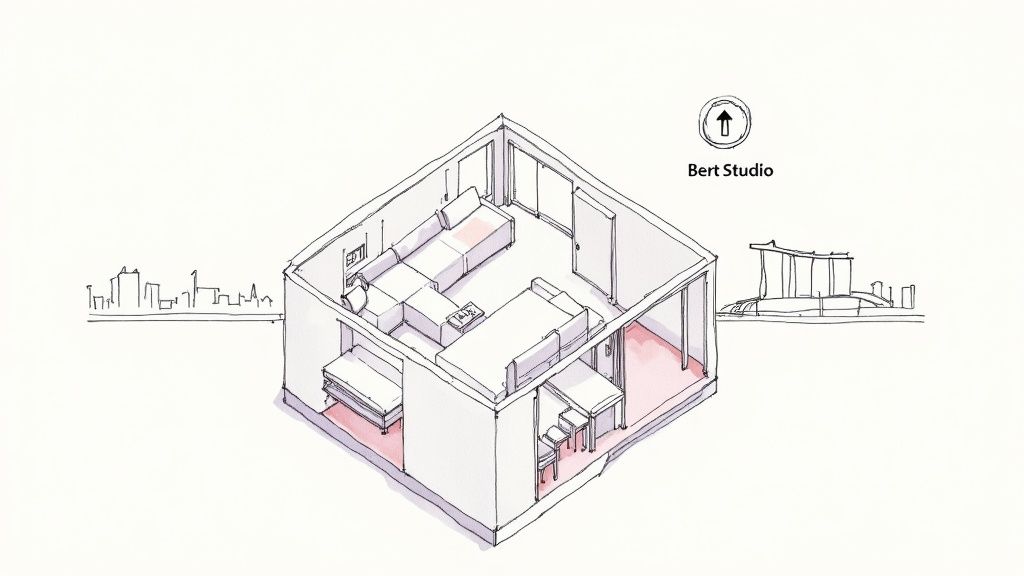
When you think of a studio apartment in Singapore, you're picturing the ultimate in efficient city living. It’s essentially a single, self-contained space where your living room, bedroom, and kitchenette all share one open-plan area. The only separate room is the bathroom, making it a perfect, compact home for singles, young couples, and expatriates navigating the city's dynamic property scene.
What Defines a Studio Apartment in Singapore
Think of a studio as your own personal hub, with everything you need cleverly designed into one main room. The key difference between a studio and a one-bedroom apartment is the lack of a wall separating the sleeping area from the rest of the home. This open-concept approach is a game-changer in a space-conscious market like Singapore's, where every square foot counts.
The whole idea is to create a seamless living experience. Your bed might be tucked into one corner, your cozy living setup in another, and a compact kitchenette lining one of the walls. Only the bathroom stands alone, offering that essential bit of privacy. It’s a design that feels fluid and modern, practically tailor-made for a minimalist lifestyle.
The Anatomy of a Studio Layout
While the exact blueprint can differ from one condo to the next, most studio apartments in Singapore share some common DNA. They typically fall somewhere between a cozy 250 square feet and a more generous 600 square feet. The smaller units are often affectionately called "shoebox" apartments—a testament to how cleverly they pack function into a tiny footprint.
Here’s what you can almost always expect to find inside:
- A Combined Living and Sleeping Space: This is the heart of the home, multitasking as your lounge by day and your bedroom by night.
- A Compact Kitchenette: Don't picture a sprawling gourmet kitchen. Studios usually come with the essentials: a small fridge, microwave, an induction hob, and just enough counter space to get by.
- A Separate Bathroom: This is the one non-negotiable. It’s always a private, enclosed space with a shower, toilet, and sink.
- Smart Storage: With space at a premium, clever storage is key. Look for built-in wardrobes, hidden compartments, and multi-purpose furniture designed to keep the unit feeling open and uncluttered.
This isn’t just about making do with less space; it's about embracing a whole different way of living.
A studio apartment almost forces you to live more intentionally. With limited room, you become a curator of your own life, keeping only the things that are truly useful or meaningful. It’s a kind of forced minimalism that many find liberating in a city as busy as Singapore.
Functional Differences from a One-Bedroom Unit
At the end of the day, the biggest difference comes down to a single wall. A one-bedroom unit gives you that clear, physical separation between your public and private life. It’s great for privacy, especially if you like having people over.
A studio, on the other hand, puts everything out in the open. But this has its own perks. Without interior walls chopping up the space, even a small unit can feel surprisingly airy and bright, as natural light can travel right through. And let’s be honest, cleaning is a breeze.
The choice really boils down to your lifestyle. If you crave privacy and distinct zones for sleeping and living, a one-bedroom is your best bet. But if you love an open, bright feel and want a low-maintenance home that simplifies your life, a studio apartment in Singapore is a fantastic option. Knowing this distinction is the first step to figuring out the right fit for you.
Decoding the Cost of Renting a Studio
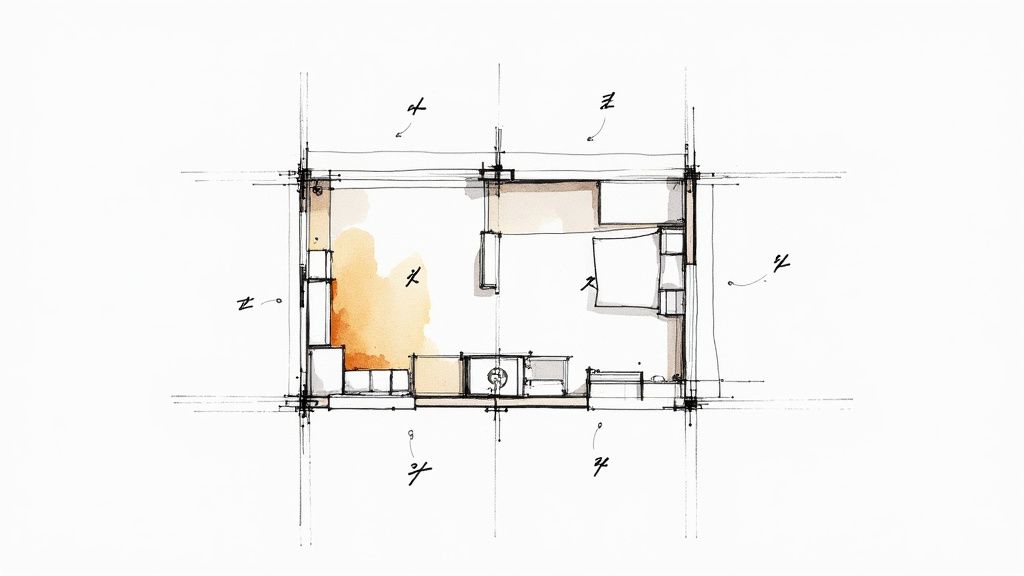
When you start looking at studio apartments in Singapore, the monthly rent figure is what grabs your attention first. But that number is just the beginning of the story. To get a real handle on your budget, you need to look past the recurring monthly payment and account for the significant upfront costs you'll face before you even move in.
Think of it this way: the monthly rent is the price of the concert ticket. It gets you through the door. But you still need cash for the ride there, the cool t-shirt, and a drink. Similarly, renting in Singapore involves more than just the base price. These initial payments are standard practice here, designed to secure the apartment and protect both you and the landlord.
The Upfront Financial Picture
Before you get those keys in your hand, you'll need to have a chunk of cash ready. These payments are typically due when you sign the Tenancy Agreement (TA) and can easily add up to several months' rent.
Here’s a simple breakdown of what to expect:
- Security Deposit: This is the big one. It’s a refundable sum the landlord holds onto as a safety net against property damage or unpaid rent. The standard is one month’s rent for a one-year lease, and two months’ rent for a two-year lease.
- Advance Rent: You'll also pay your first month's rent upfront when you sign the lease, alongside the security deposit.
- Agent Commission (if applicable): If you found your place through a property agent, you might owe them a commission. For a two-year lease, this is typically half a month's rent. The practice for one-year leases can vary, so it's crucial to confirm this with your agent right at the start.
- Stamp Duty: This is a small but mandatory government tax on your rental agreement. It officially makes your Tenancy Agreement a legal document. The amount is calculated based on your rent and lease duration.
To put it in perspective: for a studio renting at S$3,000 a month on a one-year lease, you should be prepared for an initial outlay of at least S$6,000 (S$3,000 security deposit + S$3,000 advance rent), not including any agent fees or stamp duty.
How Location Dictates Your Rent
In Singapore, the golden rule of real estate—location, location, location—is the single biggest driver of your monthly rent. The city is broadly divided into three zones, and each has a very different price tag.
- Core Central Region (CCR): This is Singapore's "prime" territory, including hotspots like Orchard, River Valley, and the CBD. Studios here offer unbeatable convenience but come with the highest price tags, often starting from S$4,000 and climbing.
- Rest of Central Region (RCR): Think of these as the city-fringe neighbourhoods—Tiong Bahru, Queenstown, Paya Lebar. They strike a fantastic balance between being close to the action and having more palatable rents, usually in the S$3,200 to S$4,500 range.
- Outside Central Region (OCR): This is where you'll find the suburban heartlands like Tampines, Jurong, and Sengkang. The OCR offers the best bang for your buck, with studio rents often between S$2,800 and S$3,500. You still get modern condo life and great transport links, just at a friendlier price.
What's fascinating is how resilient studio apartment rents are. Even when prices for larger family-sized units dip, studios hold their value. Recent data shows the median rent for studios holding strong around S$3,000 for an average 33-square-meter unit. It’s a clear sign of their steady demand from single professionals and expats. You can dive deeper into these Singapore rental market trends to see the full picture.
Other Factors Influencing Price
Of course, location isn't the only thing at play. Several other factors can make rents for two seemingly similar studios quite different, even if they're in the same area.
Proximity to an MRT Station: In a city that runs on public transport, convenience is king. A studio that’s a five-minute walk from an MRT station will always fetch a higher rent than one a 15-minute walk away. That ease of access comes at a premium.
Age and Condition of the Building: A brand-new condo with sleek, modern architecture and untouched facilities will naturally cost more. Older buildings might give you more space for your dollar but could lack the bells and whistles of newer developments.
Level of Condo Amenities: The facilities make a huge difference. A condominium boasting an infinity pool, a high-tech gym, tennis courts, and a 24-hour concierge can justify a higher rent compared to a more basic building with just a small pool.
By understanding this complete cost breakdown—from the one-off fees to the nuances of location and amenities—you can create a realistic budget and find a studio apartment in Singapore that truly fits your life and your wallet.
Discovering the Best Locations for Studios
Picking the right studio apartment in Singapore is about more than just four walls and a roof; it's about choosing your lifestyle. The neighbourhood you land in shapes everything—your daily commute, where you grab your morning coffee, and how you spend your weekends. Your perfect spot really comes down to what you value most. Are you after the non-stop energy of the city, the quiet calm of a suburban enclave, or something in between?
Imagine Singapore's property landscape as a target. The closer you get to the bullseye—the city centre—the higher the buzz and, naturally, the price. As you move outwards, life gets a bit more relaxed, and you often get more bang for your buck. The trick is to find that perfect ring on the target where your budget and lifestyle click into place.
For the Urban Enthusiast: The Core Central Region
If you feed off the city's energy and love having everything just a stone's throw away, then the Core Central Region (CCR) is where you belong. Districts like Tanjong Pagar, Orchard, and River Valley are the beating heart of Singapore's commercial and social scene. Living here means top-tier offices, world-class shopping, and some of the city’s best restaurants and bars are practically on your doorstep.
- Tanjong Pagar: A fascinating blend of historic shophouses and gleaming modern towers. It's a magnet for professionals working in the CBD, brimming with trendy cafes and sophisticated bars.
- Orchard: Singapore’s legendary shopping paradise. A home near Orchard Road offers unrivalled retail therapy, prestigious clubs, and surprising pockets of green like the Singapore Botanic Gardens.
- River Valley: Offering a slightly more residential, polished feel, River Valley provides a sophisticated escape that’s still just minutes from the excitement of Clarke Quay and Orchard.
Of course, this kind of prime location comes with a premium price tag. Studio rentals in the CCR sit at the top of the market, but for many, the sheer convenience is worth every dollar. To get a better feel for these central hotspots, our guide to neighbourhoods in Singapore offers a much deeper dive.
For a Blend of Charm and Convenience: The City Fringe
Want a taste of city living without being in the thick of it 24/7? The Rest of Central Region (RCR) is a fantastic middle ground. These city-fringe neighbourhoods are often called the "sweet spot" for a reason—they perfectly mix urban convenience with local character and a more laid-back vibe.
You still get fantastic connectivity to the downtown core, but you also get to enjoy charming streets, quirky independent shops, and a genuine sense of community. Two districts that really shine here are Tiong Bahru and Paya Lebar.
These RCR districts give you a lifestyle where you can enjoy a lazy Saturday morning at a neighbourhood café and still be in the CBD in under 20 minutes. It's truly the best of both worlds.
Tiong Bahru is famous for its unique Art Deco architecture, indie bookshops, and artisan bakeries, all nestled alongside a classic wet market. Paya Lebar, on the other hand, has blossomed into a major commercial hub with modern malls and Grade A offices, all while holding onto its rich cultural roots.
To help you visualise the options, we've put together a table comparing some of the most popular districts for studio living across the island.
Studio Apartment Hotspots by Region
| Region | Popular Districts | Key Characteristics | Estimated Monthly Rent (Studio) |
|---|---|---|---|
| Core Central (CCR) | Orchard, River Valley, Tanjong Pagar | Prime location, ultimate convenience, vibrant nightlife, luxury living. | S$4,000 - S$6,500+ |
| City Fringe (RCR) | Tiong Bahru, Paya Lebar, Queenstown | Great balance of accessibility and local charm, trendy cafes, strong transport links. | S$3,200 - S$4,800 |
| Suburban (OCR) | Tampines, Jurong East, Punggol | Value for money, self-sufficient towns, family-friendly, quieter environment. | S$2,800 - S$3,800 |
This comparison clearly shows that you don't have to sacrifice modern amenities to find a rental that fits your budget.
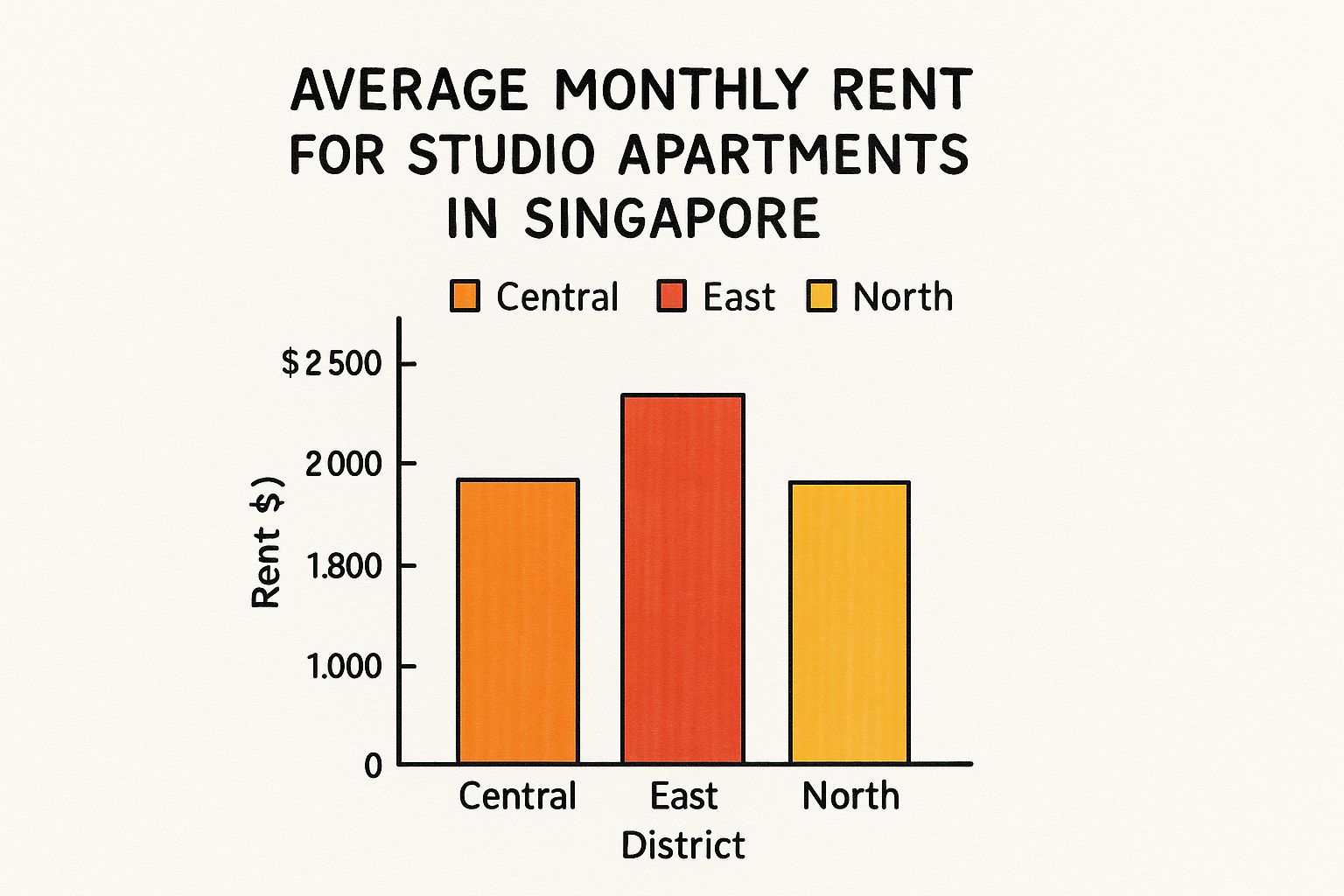
For the Budget-Conscious Renter: The Suburban Hubs
If getting the best value is your main goal, it's time to look towards the Outside Central Region (OCR). But don't let the word "suburban" fool you into thinking "remote." These areas are fully-fledged, self-sufficient towns with their own MRT stations, sprawling malls, lush parks, and even major business hubs.
Take Tampines in the East, for example. It offers modern condo living at a much more approachable price point without feeling disconnected. The rental market out here is buzzing. In the first quarter of the year alone, the private rental market saw transaction volume jump by 3.2%, with rents ticking up by 0.4%.
Suburban hotspots are a huge driver of this activity. For instance, in Punggol's Watertown development, one-bedroom units—which have a similar appeal to studios—were fetching median monthly rents around S$3,100. This signals strong demand for well-connected homes with great amenities in the OCR.
Ultimately, choosing a home in the OCR might mean a slightly longer commute into the city, but the trade-off is more space, a quieter setting, and significant savings. For anyone looking to make their budget stretch further without compromising on Singapore's high quality of life, it’s an excellent choice.
Embracing the Compact Living Lifestyle
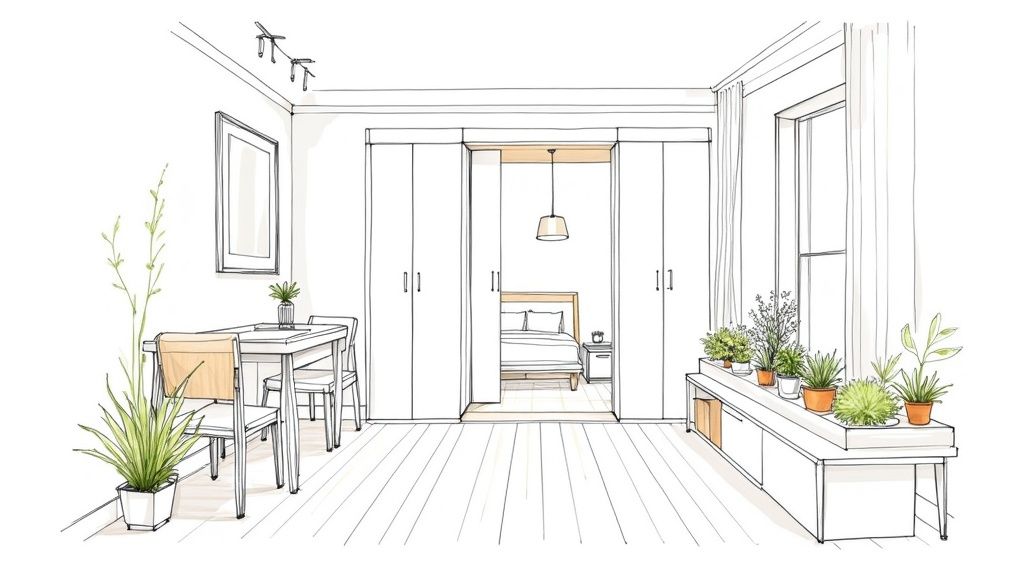
Choosing a studio apartment in Singapore isn't just about saving on space; it’s a deliberate shift towards a smarter, more efficient way of life. In a city as fast-paced as Singapore, it’s a strategic choice to get back your most precious resource: time. You’re essentially trading extra, often unused, square footage for more freedom, lower expenses, and far less upkeep.
Think of it as a lifestyle upgrade focused on efficiency. The smaller footprint has real, tangible benefits that simplify your day-to-day. Less room to manage means significantly less time spent cleaning. Instead of losing your weekends to chores, you can be out enjoying everything the city has to offer.
The Practical Perks of Compact Living
The upside of a smaller, more manageable home goes well beyond a quick cleaning routine. Studio living almost forces you to be more intentional with what you own, which pays dividends both financially and mentally.
Here are some of the practical perks you’ll notice right away:
- Lower Utility Bills: It takes a lot less energy to cool, light, and power a smaller space. Your monthly electricity and water bills will be noticeably friendlier on your wallet compared to a larger apartment.
- A Push Towards Minimalism: When storage is at a premium, you naturally become more discerning about your belongings. This helps you sidestep clutter and focus on what’s truly useful or meaningful, creating a more organized and peaceful home.
- Strategic Financial Savings: The one-two punch of lower rent and cheaper utilities frees up a surprising amount of your budget. That extra cash can go towards savings, investments, travel, or simply enjoying Singapore’s amazing food and entertainment scene.
This way of life is a perfect match for busy professionals, expats, or anyone who values experiences over possessions. If you're new to this, getting some tips on how to live in a studio apartment and truly thrive can be a fantastic start.
Your Living Space Extends Beyond Your Front Door
There’s a common myth that studio living means your whole world shrinks down to a few hundred square feet. The reality, especially in Singapore's modern condos, is quite the opposite. The incredible facilities on offer act as a massive extension of your home.
Think of the condo's facilities as your shared, oversized living room, backyard, and private club. Your compact studio is just the private retreat within this larger ecosystem of luxury and convenience.
Picture a typical day: you could start with a workout in a state-of-the-art gym, spend the afternoon working from a quiet co-working lounge, and then unwind by the infinity pool. On the weekend, you can host friends at the BBQ pits or function rooms. These aren't just add-ons; they are a core part of the experience.
This setup creates a perfect balance. You have your private, low-maintenance sanctuary to come home to, complemented by a wealth of shared spaces for work, socializing, and relaxation. A studio apartment in Singapore isn't about living with less; it’s about living with more of what actually counts.
Evaluating Studios as a Real Estate Investment
Beyond its function as a compact, efficient home, a studio apartment in Singapore can be a surprisingly shrewd addition to a real estate portfolio. When you start looking at it through an investor's lens, the focus shifts from lifestyle perks to financial performance. The appeal is immediately obvious: with a lower entry price, it's one of the most accessible ways to get your foot in the door of the private property market.
This affordability isn't just about the initial sticker price. The lower quantum means that all the related costs, like the Buyer's Stamp Duty (BSD), are also much easier to swallow. This financial accessibility opens up property investment to first-timers or those looking to diversify their assets without committing the significant capital a larger, family-sized unit demands.
Analyzing Rental Yield and Tenant Demand
For any property investor, the conversation always comes back to two things: rental yield and tenant demand. This is where studio apartments really shine. Rental yield, which is simply your annual rental income as a percentage of the property's value, tends to be higher for smaller units compared to larger ones, even within the same condo development.
Think about it this way: the rental price doesn't shrink at the same rate as the floor space. A studio might be half the size of a two-bedroom unit, but its rent is often much more than half, leading to a more attractive yield on your investment. It’s an asset built to generate efficient income right from the start.
On top of that, studio apartments in Singapore tap into a deep and consistently replenished tenant pool. The demand is constantly fueled by:
- Single Expatriate Professionals: International talent moving to Singapore for work needs a convenient, low-maintenance home base, often close to the CBD.
- International Students: Those enrolled in local universities are always looking for private, secure housing near their campus.
- Young Local Professionals: Many Singaporeans who aren't ready to buy but crave independence and the condo lifestyle are a strong source of rental demand.
This steady stream of potential tenants is a huge advantage, as it minimizes the risk of your property sitting empty for long periods and ensures a more stable, predictable income.
Owning a studio apartment is like running a boutique hotel room. The appeal is specialized, the turnover can be steady, and the operational costs are contained, often leading to better net returns compared to managing a sprawling multi-room property.
Capital Appreciation and Market Nuances
While rental income pays the bills, capital appreciation—the increase in your property's value over time—is where long-term wealth is built. Here, the story of the studio apartment gets a bit more complex. Historically, larger family-oriented units have often seen stronger capital growth because they appeal to a wider base of local homebuyers.
However, recent market trends paint a promising picture for smaller units. Over the past year, Singapore's private property market has shown robust growth, especially in the suburban and city-fringe areas where many new studio developments are popping up. Non-landed properties, including condominiums, saw a price increase of 4.74% year-on-year. This growth is partly driven by new, competitively priced launches in these regions, which signals healthy demand. For a deeper dive into the numbers, you can explore the Singapore property price history on Global Property Guide.
When weighing your investment, it's also smart to keep an eye on broader market movements, particularly in the high-end segment. Our analysis of luxury real estate market trends can offer valuable context, especially if you're considering a studio in a prime district.
The Resale Market: A Niche Consideration
The main challenge for a studio as an investment lies in its resale market. Because the target audience is narrower—mostly singles or couples without children—the pool of potential buyers is smaller than it is for a two- or three-bedroom apartment. This can sometimes mean it takes a bit longer to sell when you decide to exit your investment.
Anyone buying a studio needs to go in with a clear-eyed strategy. This isn't a property you "flip" for a quick profit. Instead, it’s an investment that rewards patience. It shines as a long-term hold, designed to generate a steady rental income for years while its value gradually appreciates in the background. It’s an asset for the investor who understands its unique place in the market.
Common Questions About Studio Apartments
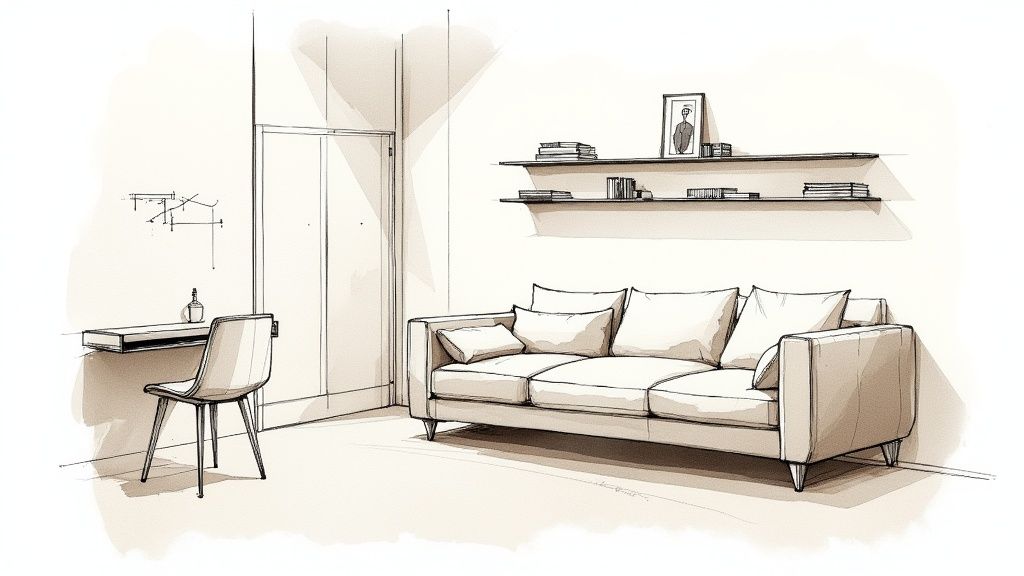
As you get closer to choosing the perfect studio apartment in Singapore, it’s completely normal to have some last-minute questions pop up. Deciding where to live is a huge step, and getting clear on the details brings peace of mind. Here, we'll tackle some of the most practical questions we hear all the time, from rental rules for foreigners to the key differences between housing types.
Think of this as your final walkthrough before making a commitment. We’ll give you straightforward answers so you can move forward feeling confident and fully informed.
Can Foreigners Rent Studio Apartments in Singapore?
Absolutely, yes. Foreigners can definitely rent private studio apartments in Singapore—in fact, it’s an incredibly common path for expats and professionals moving to the city. The process is well-established and generally quite smooth as long as you hold a valid long-term pass.
To rent a private condo unit, landlords just need a few key documents to verify your legal right to reside in Singapore:
- A Valid Pass: This could be an Employment Pass (EP), S Pass, Dependant's Pass, or a Student Pass.
- A Copy of Your Passport: This is standard for identity verification.
The rental process itself is very straightforward. You'll sign a Tenancy Agreement (TA), which is the legal contract that lays out all the terms of your lease. When you sign, you'll also pay a security deposit. This is typically one month's rent for a one-year lease or two months' rent for a two-year lease. It’s a refundable amount the landlord holds onto, just in case of any damages or unpaid rent when you move out.
A key legal point: Landlords or their agents must register your tenancy details with the Urban Redevelopment Authority (URA) within two weeks of the lease starting. This officially records the rental, offering protection for both you and the landlord.
There are no restrictions on foreigners renting private homes like condominium studios. This accessibility is a big reason why these compact, convenient homes are such a popular choice for international students, professionals, and anyone relocating to Singapore.
Are Private Studios the Same as HDB Studio Apartments?
This is a really important distinction, as it’s a common point of confusion. The simple answer is no—they are completely different types of property built for different people and purposes. When you see listings for studio apartments in Singapore, they are almost always referring to private properties.
Let's break it down:
- Private Studio Apartments: These are units located within privately owned condominium developments. They're available on the open market for anyone to buy or rent, including Singapore Citizens, Permanent Residents, and foreigners. These are the properties this guide is all about.
- HDB Studio Apartments: These are a form of public housing from the Housing & Development Board (HDB), now known as Community Care Apartments or 2-Room Flexi flats on short leases. They are specifically designed as an affordable housing option for Singaporean citizens who are 55 years old or older.
The crucial difference is that HDB units come with strict eligibility rules and regulations. They can't just be rented out on the open market like a private condo. So, if you're an expat or not a citizen, your search for a studio rental will be focused entirely on the private property market.
What Is the Typical Lease Duration for a Studio?
In Singapore’s private rental market, lease durations are fairly standard. The most common tenancy periods you'll come across for a studio apartment are either one year or two years.
A one-year lease gives you more flexibility, which is great if you're on a shorter work contract or just aren't sure about your long-term plans. That said, landlords often prefer the stability of a longer tenancy. Because of this, you might find that signing a two-year lease gives you a bit more negotiating power, sometimes helping you lock in a better monthly rent.
It’s also good to know the legal minimum. For private residential properties in Singapore, the law requires a lease to be for a minimum of three consecutive months. Anything shorter is considered a short-term stay (like an Airbnb or serviced apartment) and isn't allowed in private condos. This rule helps keep these buildings residential in character. For buyers thinking of a studio as an investment, it's also worth understanding how stamp duties impact your costs; our guide on the Additional Buyer's Stamp Duty covers this topic in more detail for property owners.
At UPPERHOUSE at Orchard Boulevard, we know that finding the perfect home is about more than just four walls—it’s about finding a lifestyle. Our beautifully designed residences deliver an unmatched combination of luxury, comfort, and a truly prime location. Explore your future home with us today at https://upperhouse.luxurycondo.sg.
Related Articles
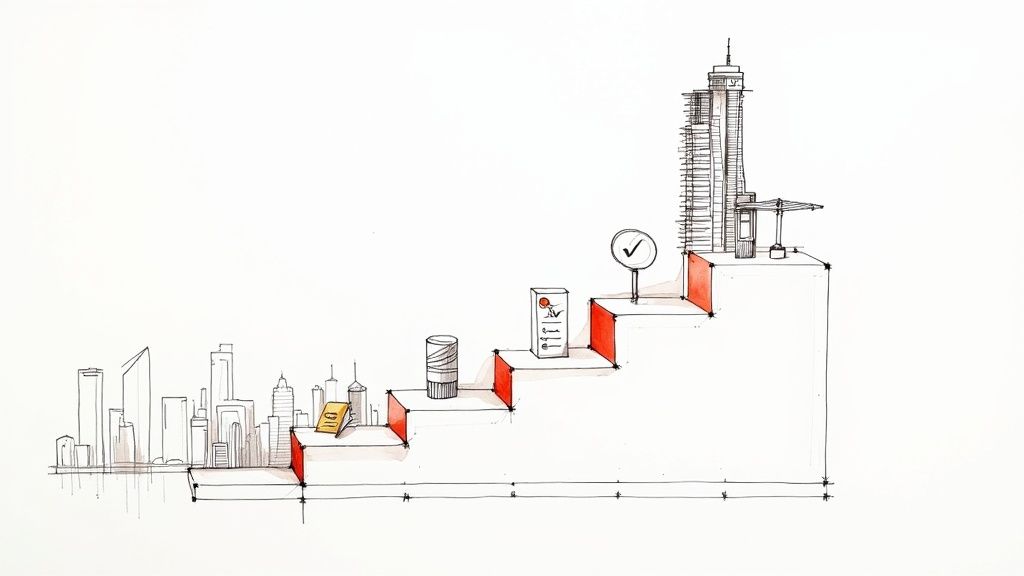
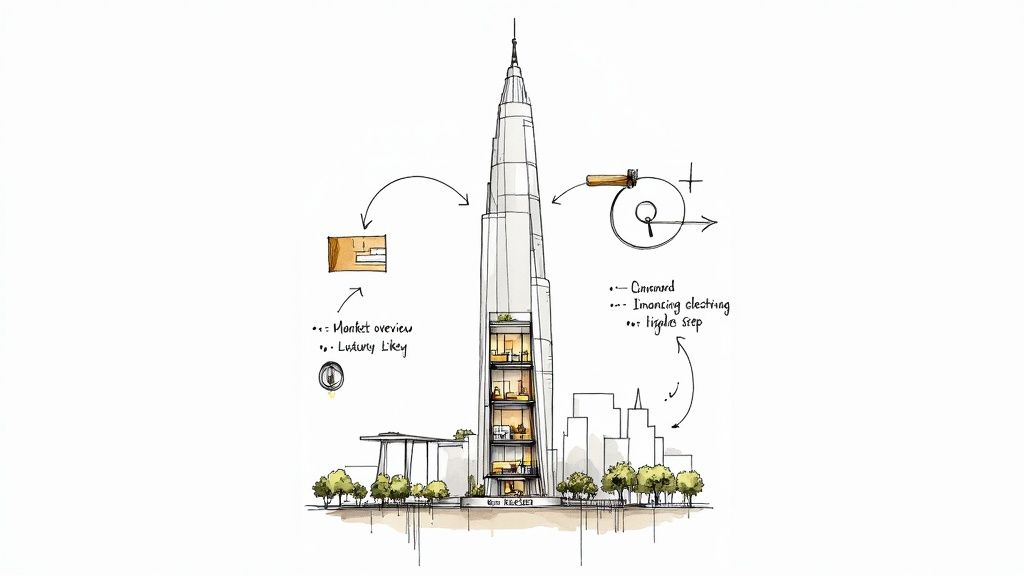

Interested in UPPERHOUSE?
Discover luxury living at UPPERHOUSE at Orchard Boulevard. Get exclusive updates and be the first to know about availability.